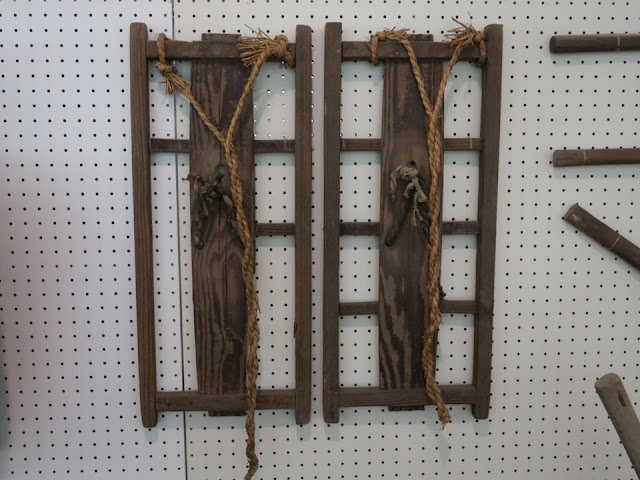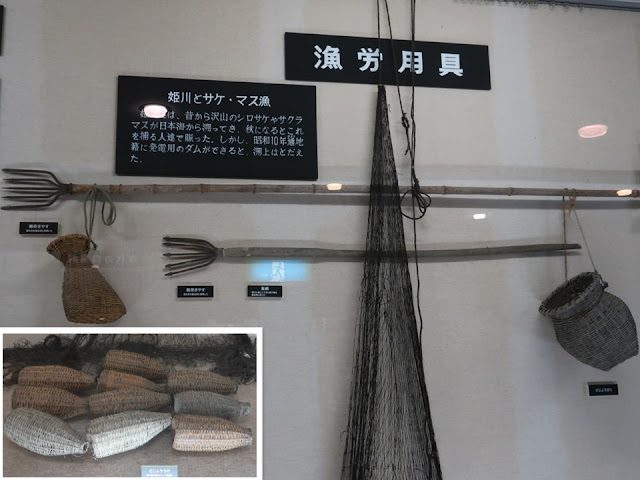Hakuba village is famous for a mountain resort which many foreigners visit especially in winter. In the museum, we can understand the mountain work and life in the old days well. The clothes and tableware of the section of a special day such as a wedding ceremony tell us how people enjoyed an event.
日本を代表する山岳リゾートの長野県・白馬村にある資料館です。昔の山での仕事、暮らしがよく分かります。また、結婚式のようなハレの日の衣服や食器を展示したコーナーがあり、ハレの日にどんな楽しみ方をしていたのか、その一端を知ることができました。
The museum is in an administration office of Hakuba Green Sports Forest which has BBQ site and so on. There is no dedicated staff of the museum; it is a good idea to reduce cost. Generally, visitors to a local museum are not so many.
アスレチックやBBQなどの施設がある白馬グリーンスポーツの森の管理棟の中に資料館があります。独立した資料館は来訪者が少ないので、よいアイデアだと思います。
Large agricultural equipment is set in center, various tools and utensils are displayed along the walls.
展示室の中央に大型の農機具が展示され、壁際にさまざまな仕事の用具などが展示されています。
The section is about “Salt Road”, which links Itoigawa (seaside city) and Matsumoto (inland city). Hakuba is on the road.
塩の道の模型と地図。糸魚川から松本まで114.8km、白馬村を縦断しています。
The section shows us clothes, tableware and so on which were used on a ceremonial day (sorry for the reflection of the map).
塩の道の地図が映り込んでいるのですが、昔の儀礼の着物や食器をまとめて展示したコーナーがあります。
Foods were served on the utensils above. Trays were put on a tatami matt; guests sat down in front of the trays. Cooked or pickled vegetables, seaweed and so on were prepared. Those were available even in a mountainous area. Btw, we Japanese basically didn’t eat animal meat back then. It was an influence of Buddhism.
右上の「さき皿」には、なますや香の物を入れ、左下の「平鉢」には、凍豆腐、ごぼう、昆布の味付けなどを入れたと書かれています。山間部の宴会料理がよく分かります。
Jugs on the left were used to serve sake (alcohol), tea or hot water. The bowl with a lid was used to serve simmered foods such as tofu.
左の湯涌は、酒、茶、湯などを注ぐときに使い、右の太平鉢には、よせ、ちくわ、凍豆腐、野菜などを入れました。煮物ですね。
The title of the section is “Hemp and life”. People had planted hemp since the ancient era. However, they don’t do it now because of spread of synthetic fibers.
「麻と生活」というコーナーです。古代から麻の栽培が盛んでしたが、今は、化学繊維に押されて栽培は途絶えたとのことです。
Vegetable dyeing is exhibited in the next section. The natural material exuded soft and excellent vibes above. The technique was also disappeared because of spread of chemical dyestuff.
隣では、「草木染め」が紹介されています。天然素材ならではの、やさしくて上品な色味です。この技法も化学染料の発達とともに失われていきました。
Equipment for mountain works、山樵の用具
The sled was used to bring lumbers out from a mountain. They did it in winter because the snow reduced the friction. They were often injured while moving heavy things.
木を山から下ろすソリ。雪が積もった後にソリで下ろすのが楽だったようですが、重量物の運搬では怪我が絶えませんでした。
Outfits for mountain works. Japanese were around 10 cm shorter back then.
山仕事の装束ですが、昔の人は小さいですよね。
They were short, however, their lunch boxes were big.
弁当箱は大きい。体は小さくてもたくさん食べました。
Barks were material of coats for a snowy season.
雪を除ける蓑には、しゅろなどの樹皮が使われました。
Equipment for rice farming、稲作用具
The name of the wooden sandal is named "big feet". People used them when they treaded field in order to make the land flat and so on. It was a typical physical work.
「大足」は、刈敷を踏みつけるときや代掻きの仕上げに使ったとありますが、一歩一歩、力の要る作業です。
The small baskets on the left were used to bring seedlings, the big one on the right was used to bring compost to field. We can imagine the farmers who shouldered them.
左の二つは苗を運ぶ籠、右の大きなのは田畑へ堆肥を運んだ籠です。道具を使った人が思い浮かびますね。
Threshing and sorting after harvest、収穫後の脱穀、選別
Equipment for river fishing、漁撈用具
Spears to stab salmon or trout which went up the river and devices to catch loach (lower left) are displayed. After a hydroelectric dam was constructed in 1935, salmon and trout don’t swim upstream. We do not depend on the gifts of nature so much now.
姫川を登ってくる鮭や鱒を捕る道具、田や水路のドジョウを捕るための仕掛けです。昭和10年に発電用のダムができ、鮭や鱒は来なくなりました。今や、私たちは、自然の恵みに頼らず生きています。
Mountain climbing、登山
The history of climbing is shown; Hakuba is a mountain resort. It says, “Before the 20th century, Hakuba mountains were place which only workers (hunters, medical plant collectors. miners) went into the forests and only mountain worshippers climbed to the top. High mountains were sacred place, especially the summits were deities dwelling places. Therefore, people were deeply afraid of polluting or desecrating summits.” That’s the traditional thought about high mountains.
登山のコーナーもあります。土地柄ですね。「明治以前の白馬連峰は、猟師、鉱脈探査、採薬などを生業とする人々と、雨乞いなど信仰のために僅かな人達のみが登る山で、一般に、岳は神聖な場所、山頂は神の聖座でみだりにけがしてはならないと、恐れられていた」と書かれています。なるほど。
Miyao residence (built in 1864)、宮尾家(1864年築)
The house was moved to the museum site and is open to the public.
飯森から移築されて公開されています。
There is a bedroom behind the living room.
茶の間の奥に寝間があります。
Bedroom. The couple laid inside the wooden box and wore the coat in it, probably. The tiny space should be comfortable for Japanese.
寝間では、木の箱に入って、かいまき布団を着て寝るようです。狭いスペースがよいのでしょうか。
There is a room with an altar next to the living room. There are three guest rooms in behind. The residence was owned by a exalted family, I’m sure.
茶の間のとなりの居間(御上)の先には三間続きの座敷があります。格式の高い家ですね。
People gathered grasses for horses in morning. He shouldered lots of grasses.
馬草刈りは、朝早く食前の仕事として行われました。朝飯前ですが、多量に背負っています。
Chikuni highway (Salt Road)、千国街道(塩の道)
Visited in August, 2023
Official website: https://www.vill.hakuba.lg.jp/gyosei/soshikikarasagasu/shogaigakushusportska/hakubamurakominkan/3/8410.html
(in Japanese. Automatic translation is attached), accessed in August, 2024
Beautiful settlement in Hakuba village ご参考:Ozenki
residence in Aoni hamlet、青鬼集落・お善鬼の館
Previous post (museum in the neighboring city which is on the road from Matsumoto
to the Sea of Japan): Chouji-ya
(Salt Road museum)、塩の道 ちょうじや
Next post (museum in the neighboring village which is also on the road from Matsumoto to the Sea of Japan): Otari local museum、小谷村郷土館


























Comments
Post a Comment